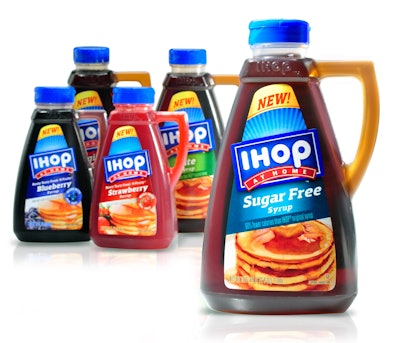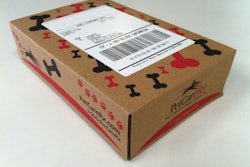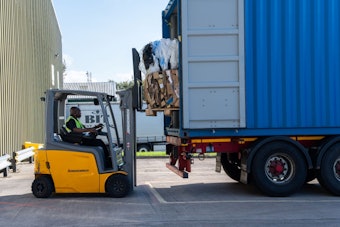The recent lightweighting of retail water bottles illustrates the double-edged sword of efficient production and shipping vs. consumer acceptance and perceptions of quality. There may be a fine line when it comes to the many expectations consumers harbor about their experiences with primary packaging, and what they consider “cheap.”
1. List all the factors and goals. In the early design phases, identify specific capacities while maintaining form and ergonomic intent. Then make sure to maintain structural integrity. Consider every aspect of the packaging requirements and restrictions: material cost, manufacturing speed, assembly, pallet efficiency, labeling, retail, etc. Consider investing in a proprietary structure, because structure is one of the main equities a brand can have and own, and it’s one of the primary ways to differentiate on shelf. Briefs have a tendency to be constricting, but there’s still room to create unique design, because even small design elements differentiate.
2. Understand competing goals and possible compromises. If there are tight restrictions in the design brief, find out who put them there. Rigid structure design is design with a big “D”, because so many factors are competing for primacy as compromises are made between form, function, strength, and protection. Try to look at restrictions as challenging opportunities for innovation instead of insurmountable obstacles. Determine minimal wall thickness first at the most critical area of the package, then use design to stiffen structures where material reduction makes it challenging to have the same load weight requirements. Don’t let others override this step; it’s not okay to say: “We’ll rework it later.”
3. Research consumer attitudes and expectations. It’s important to consider cost as well as consumer perception of packaging material use, which could cheapen the product’s appeal. Consumers’ desire for convenience has become more about versatility in a multitude of use environments. Think about how to make the user more functional with the package and how product delivery can be designed within a broader system. Remember, consumers expect more and more to be able to see the product and see its features—even interact with it—at retail. For durable goods applications, include a “Try Me” window without reducing the integrity of the package or its functionality in respect to product protection, pilfer-resistance, or durability. (For more on research, read “Consumer research and its limitations” in this Playbook.)
4. Appreciate differences in molding techniques. Consult suppliers frequently, because they’re often the experts. Aside from cost, also consider assembly, filling, consumer perception, and disposal. Consider PET for small runs, because you can get a few thousand bottles for a reasonable price, and be sure to find high-density polyethylene blow molders with robust software to determine optimal plastic distribution. Stress testing packages under extreme conditions may provide the key information you need when determining what material is best for the application.
5. Get a handle on it...or not. Incorporating a handle into a rigid container is a highly complex engineering process. The specifics depend on the molding technique of the primary container. As a designer, you need to pay careful attention to weak points, flashing, sharp edges, pinch points, ergonomics, and other human factors. To cut the cost of designing and molding a handle into the primary package, evaluate the cost of a secondary component handle that attaches to the outside of the package. But keep in mind how that handle might affect the recyclability of the total package.
6. Maximize the potential of thermoforming. Specific concerns when developing thermoformed containers include stacking strength, ability to seal tightly, and lid strength. Consider the versatility of adding a thermoform inside other packaging formats. Thermoforming enables great design freedom, with some limitations. Whenever possible, take the time to stress test both empty and filled packaging components. Thermoforms may not be right for every situation because of their sharp angles and the added complications of assembly.
7. Consolidate your brand identity. Design label or print graphics and container shape at the same time. There is a dialogue that happens between graphics and shape that makes the sum of that dialogue greater than its parts. The package in isolation should tell you what category it’s in, but also have an architecture that is adaptable to new categories. Plan ahead for extensions, and decide what structural elements will be constant and what will be variable. Try to marry the best consumer ergonomics benefits with the best production efficiencies.
8. Cap it off right. Though often small in size relative to the bottle, pouch, or tube container it caps, closures can have the biggest impacts for consumer functionality, ease of use, and comfort. That’s because the closure is often the primary point of interaction the consumer has with the product and package. It’s a common mistake to think of a closure separately from the container, or downplay its importance. (For more, see “Closure best practices keep possibilities open” in this Playbook.)
9. Test, test, and then test some more. Build in development time, testing time, and redevelopment time. Anticipate what can go wrong by using tools such as DFMEA (Design Failure Mode and Effects Analysis). Realize that there may be some trade-offs in the performance of recycled-content plastic containers. Know the shortcomings and flexibility in procurement before committing to a long campaign. If budget allows, explore multiple material options from various vendors to maximize your success rate.
10. Manage the process stem to stern. Communicate all the risks in production to all the stakeholders, and enlist a backup person to corroborate. Engineers should know the minimal needs of the product, and design should enhance the promise of the brand. Learn the languages of your collaborators. If you’re in production, learn about aesthetics and engineering. If you’re an engineer, learn about production and aesthetics. And if you’re a designer, learn more about engineering and production. Be prepared to discuss and make suggestions early as to what is possible—and what is not, and why.
11. Don’t be afraid of loftier goals. Recyclability and reduction in materials often get the most attention in working toward a more sustainable future. But package design can change consumer behavior in more pervasive ways. Does your package allow for complete dispensing of the product? Can the package be reused, refilled, or used for another purpose? Remember anything is possible, so use all your resources to flesh out new ideas. Stay positive in meetings and listen to your sales colleagues who are on the front lines. But be forewarned, to change behavior on a mass scale often requires a big investment in materials, design, and education.
Liked this article? Download the entire playbook here.



























